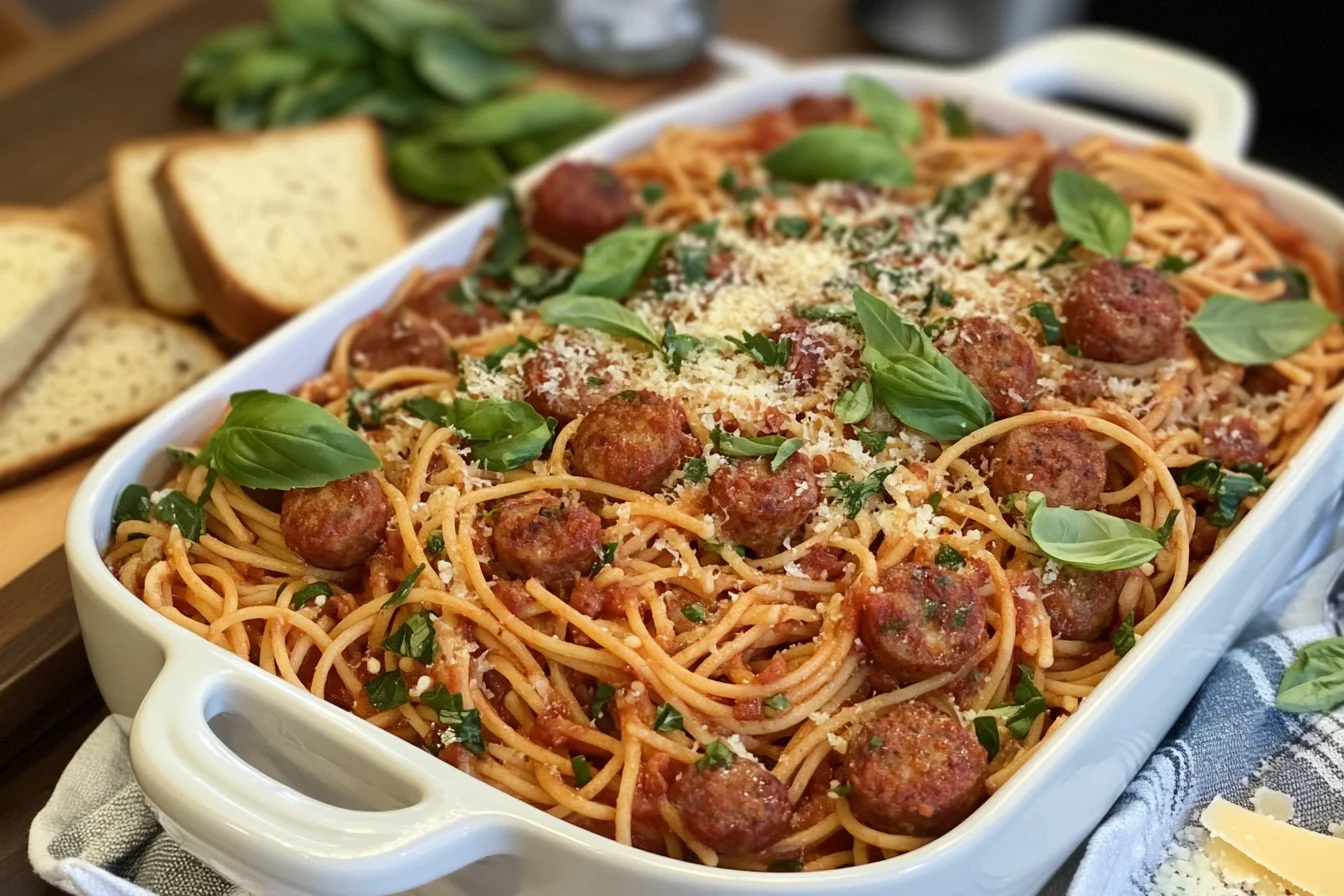Table of contents
Let’s face it, there are few things in life more comforting than a big bowl of spaghetti, especially when it’s loaded with savory sausage. Sausage spaghetti isn’t just a meal; it’s a hug in a bowl, a weeknight dinner savior, and a crowd-pleasing favorite. Whether you’re a fan of a simple marinara sauce or prefer something a little more complex, this dish is incredibly versatile and always satisfying. So, let’s dive in and explore the delicious world of sausage and spaghetti!
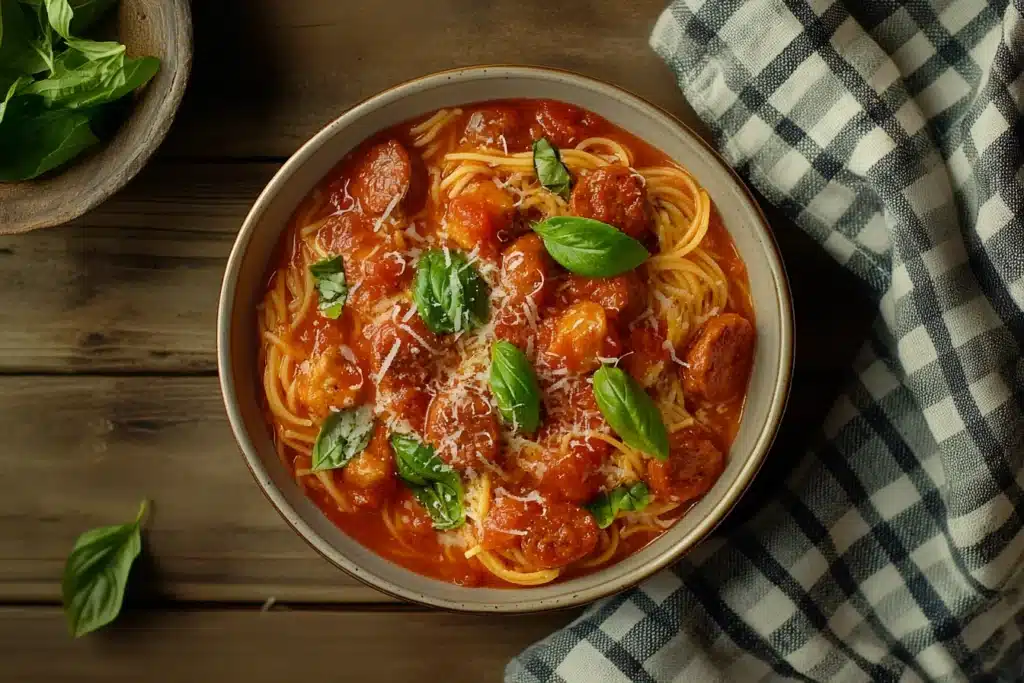
Why Sausage Spaghetti is a Go-To Meal
Why is spaghetti with sausage such a beloved classic? There are many reasons, my friends! This dish hits all the right notes, and it’s truly a winner. Here are a few reasons why sausage spaghetti should be in your regular rotation:
- Hearty and Satisfying: The combination of carbohydrates from the pasta and the protein from the sausage makes for a meal that will keep you full and happy. In addition, it’s a great way to get a good source of protein and carbohydrates in one meal.
- Flavorful and Versatile: Sausage comes in many varieties, each with its unique flavor profile. From sweet Italian sausage to spicy chorizo, you can create endless flavor combinations. Therefore, you can adapt the dish to any preference.
- Easy to Make: This is a recipe that can be thrown together relatively quickly, making it perfect for busy weeknights. You don’t need to be a gourmet chef to whip up a delicious sausage spaghetti dish. Not only that, but it is also an easy recipe that is great for novice cooks.
- Family-Friendly: Kids and adults alike love this dish. It’s a crowd-pleaser that’s sure to be a hit with everyone at the table. Also, because of its simplicity, it appeals to even the pickiest of eaters.
- Customizable: Feel free to add your favorite vegetables, herbs, and spices. There are so many different ways you can customize your spaghetti with sausage to your exact taste. Besides, it’s an easy recipe to customize according to your personal preferences.
Key Ingredients for the Best Sausage Spaghetti
- Spaghetti: The classic choice for this dish, but feel free to use other pasta shapes like linguine, penne, or bucatini if you prefer. Similarly, there are many types of pasta that go well with this dish.
- Sausage: Italian sausage (sweet or hot), chorizo, or even breakfast sausage will work wonderfully. Choose your favorite type based on the flavor profile you’re aiming for. Also, the type of sausage will drastically change the flavor profile of the final dish.
- Tomato Sauce: You can use store-bought marinara sauce for convenience, or make your own from scratch for a more authentic taste. While store-bought sauces are great, making your own is truly an elevated experience.
- Onion and Garlic: These aromatic vegetables form the base of most great sauces and provide a lot of depth of flavor. In addition, they are a must for a flavorful and fragrant sauce.
- Olive Oil: Used to sauté the vegetables and sausage, adding richness and flavor to the dish. Furthermore, it provides a great base for building layers of flavor.
- Dried Herbs: Italian seasoning, oregano, basil, or red pepper flakes can be used to enhance the flavor of the sauce. Therefore, herbs and spices are a great way to add complexity to the dish.
- Parmesan Cheese: Freshly grated Parmesan cheese is the perfect finishing touch to this classic dish. Certainly, Parmesan cheese is a must for any Italian dish!
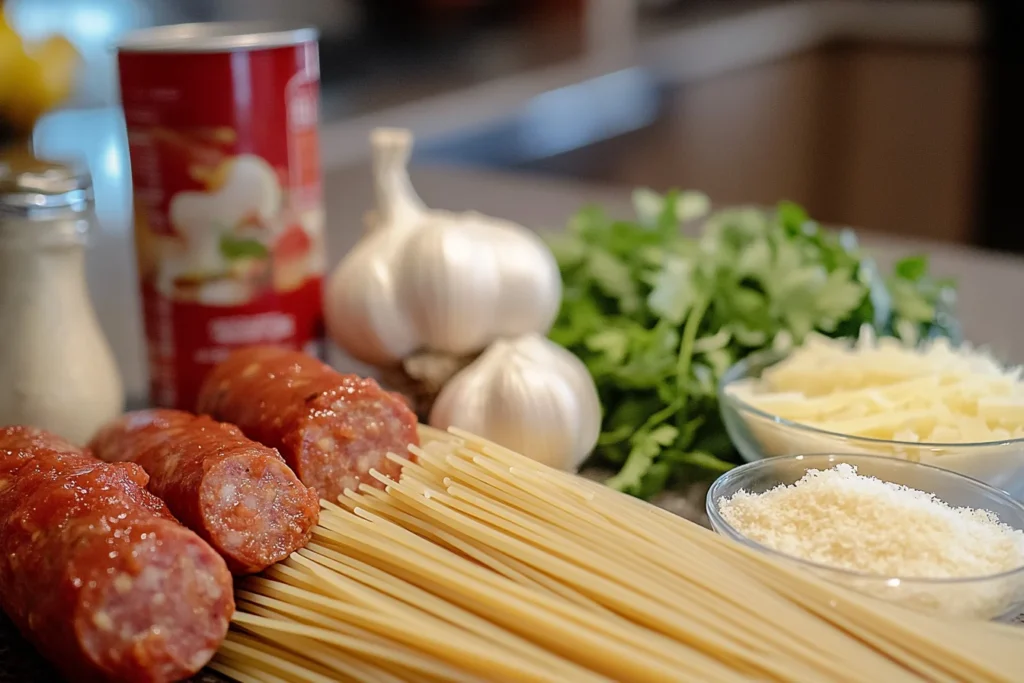
When selecting your sausage, consider using high-quality Italian sausage, which is often made with coarsely ground pork and seasoned with fennel and other spices, and for more information on this type of sausage, you can check out Easy Italian Sausage Spaghetti
Step-by-Step Guide to Making Perfect Sausage Spaghetti
Ready to get started? Here’s a simple guide to making a delicious sausage and spaghetti dish:
- Cook the Pasta: Cook the spaghetti according to package directions until al dente. Drain and set aside. Consequently, this will prevent the pasta from getting soggy.
- Prepare the Sausage: Remove the sausage from its casing (if necessary) and crumble it into a large skillet or pot. Cook over medium heat, breaking it up with a spoon, until browned. In addition, this step is essential for building a strong flavor profile.
- Sauté the Vegetables: Add the diced onion and minced garlic to the skillet with the sausage. Cook until the onions are translucent and the garlic is fragrant. Similarly to the previous step, this further adds layers of flavor and aromatics.
- Add the Tomato Sauce: Pour the tomato sauce into the skillet with the sausage and vegetables. Stir well to combine. Furthermore, make sure to coat all the elements well.
- Simmer the Sauce: Bring the sauce to a simmer, then reduce the heat to low. Add your favorite dried herbs and spices. Let the sauce simmer for at least 15-20 minutes, or longer, to allow the flavors to meld together. Stir occasionally. Because the simmering process will create a deeper and richer sauce, try not to skip this step.
- Combine the Pasta and Sauce: Add the cooked spaghetti to the sauce and toss to coat. Make sure every strand is covered with delicious sauce. Also, this is the time to incorporate all the flavors together and create a harmonious blend.
- Serve: Serve immediately, topped with freshly grated Parmesan cheese and your choice of optional garnishes (fresh basil, red pepper flakes, etc.). Enjoy! Finally, it’s time to indulge and savor the flavors you created!
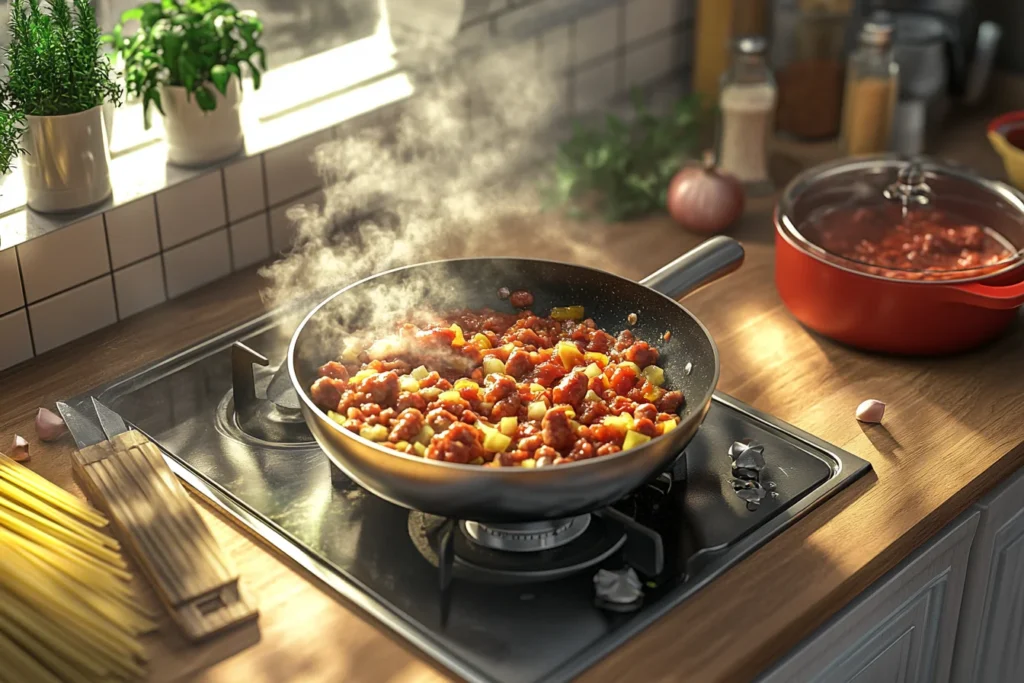
Tips and Tricks for the Best Sausage and Spaghetti
Want to take your sausage spaghetti from good to great? Here are a few pro tips:
- Don’t Overcook the Pasta: Always cook your spaghetti al dente, which means “to the tooth.” It should have a slight bite to it. Overcooked pasta will be mushy. While this is important with all dishes, it’s crucial for pasta dishes.
- Brown the Sausage Properly: Don’t rush the browning process. This will help develop a rich, deep flavor. Similarly, it is essential to build up the flavor.
- Simmer the Sauce: Simmering the sauce for a longer period of time allows the flavors to meld together beautifully, so be patient. Also, patience is a virtue, especially in the kitchen.
- Taste as You Go: Season your sauce to your liking, adjusting the herbs, spices, and salt and pepper as needed. Therefore, don’t forget to add seasoning as per your liking.
- Use Fresh Ingredients: Whenever possible, use fresh ingredients like garlic, onions, and herbs for the best flavor. Certainly, fresh ingredients will elevate the flavors of your dish.
- Add a Touch of Wine: If desired, add a splash of red wine to the sauce for extra depth and flavor. Let it simmer for a few extra minutes to allow the alcohol to cook off. Additionally, this creates a richer and more complex flavor profile.
- Garnish Creatively: Don’t underestimate the power of garnishes! A sprinkle of fresh basil, a dash of red pepper flakes, or a dollop of ricotta cheese can elevate the dish to another level. Besides, a garnish is a great way to add a final touch to the presentation of your dish.
Nutritional Information for Sausage Spaghetti
It’s always good to know what you’re putting into your body! Here’s a general breakdown of the nutritional information for a single serving of sausage spaghetti. Keep in mind that these values can vary depending on the specific ingredients and portion sizes:
| Nutrient | Amount (per serving) |
| Calories | 500-700 |
| Total Fat | 25-35g |
| Saturated Fat | 10-15g |
| Cholesterol | 80-120mg |
| Sodium | 800-1200mg |
| Total Carbohydrates | 60-80g |
| Dietary Fiber | 5-8g |
| Total Sugars | 8-12g |
| Protein | 25-35g |
Note: This is just an estimate. For more precise data, please use a nutrition calculator with the exact amounts of each ingredient you use. However, keep in mind that the exact amount may vary based on your ingredients.
Serving Suggestions for Your Sausage Spaghetti
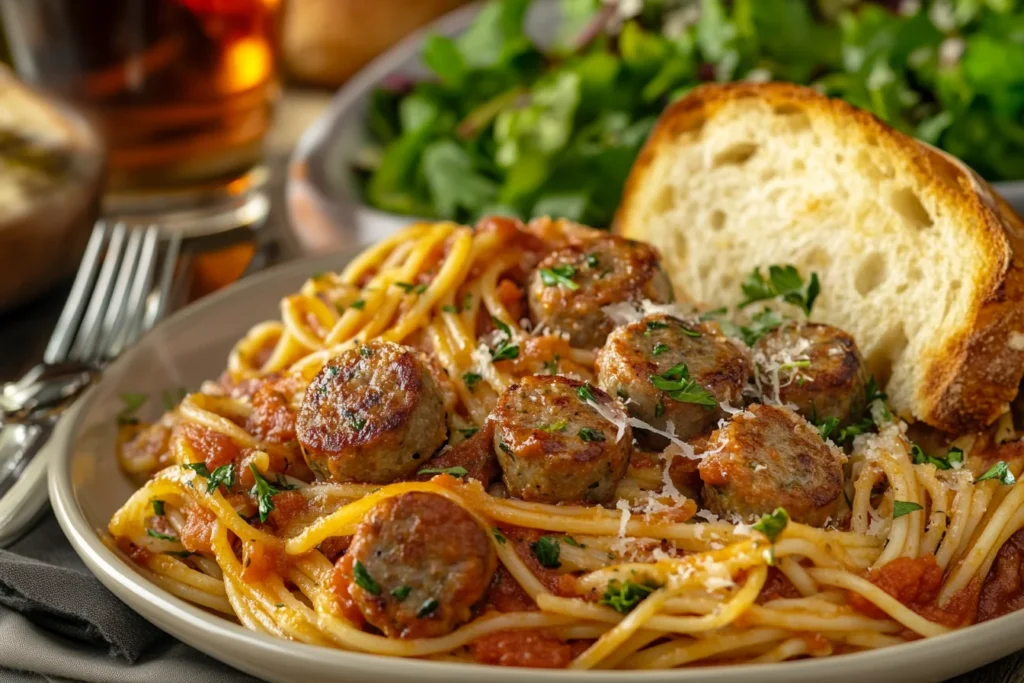
Now that you’ve made your delicious sausage and spaghetti, what do you serve it with? This dish is a meal on its own but here are a few ideas to make it an even more amazing experience:
- Garlic Bread: A classic pairing that’s always a hit. The garlic bread soaks up all that delicious sauce. Also, garlic bread is a perfect complement to this classic pasta dish.
- Side Salad: A light and refreshing green salad can help balance out the richness of the dish. Similarly, it’s a great way to add some freshness to the meal.
- Roasted Vegetables: Roasted broccoli, asparagus, or bell peppers would be a great addition to this dish. Furthermore, they create an added layer of flavor and texture.
- Wine: A glass of red wine, such as Chianti or Cabernet Sauvignon, complements the flavors of the dish beautifully. In addition, it elevates the dining experience with a perfect pairing.
- Dessert: A simple dessert like tiramisu or cannoli would be a perfect way to end your meal. Finally, a touch of sweetness is the perfect way to end this hearty meal.
Variations of Sausage Spaghetti
While the classic version is delicious, there are endless ways you can adapt this spaghetti with sausage recipe to your liking. Here are a few ideas:
- Spicy Chorizo Spaghetti: Use chorizo sausage for a spicy kick. Add extra red pepper flakes for even more heat. Similarly, this adds a great level of heat to the dish.
- Creamy Sausage Spaghetti: Add a splash of heavy cream to the sauce for extra richness. Parmesan cheese is key to add even more flavor to this creamy variation. Also, heavy cream is a great way to add richness and depth to the sauce.
- Sausage and Vegetable Spaghetti: Add your favorite vegetables like bell peppers, mushrooms, zucchini, or spinach for extra nutrients and flavor. In addition, it’s a great way to sneak in extra veggies.
- Baked Sausage Spaghetti: Layer the cooked spaghetti, sauce, and cheese in a baking dish and bake until bubbly and golden brown. Not only that, but it’s also a great way to add a bit of crispiness to the top.
- White Wine Sausage Spaghetti: Use white wine for an alternative flavor profile and add some lemon for an elevated taste. Therefore, white wine and lemon offer a lighter and brighter alternative to classic red sauces.
- Pesto Sausage Spaghetti: Stir in some pesto sauce into the sauce for a delicious herby flavor. The combination of pesto and tomato is amazing. Besides, pesto is an excellent way to add a herby and nutty dimension to the dish.
- Vodka Sausage Spaghetti: For an elevated creamy tomato sauce with a hint of vodka, this is your go-to variation. It adds richness and a subtle kick that is sure to delight you. Also, this is a great way to elevate the flavor profile and add a slight kick.
Exploring Different Types of Sausages
The type of sausage you choose can dramatically change the flavor of your spaghetti. Here are a few options to consider:
- Sweet Italian Sausage: This is a classic choice with a mild, slightly sweet flavor. It’s a versatile option that works well in most recipes.
- Hot Italian Sausage: This variety offers a spicy kick, adding a delightful heat to your dish. If you like spicy food, this will be your go-to sausage.
- Chorizo: With its smoky, paprika-rich flavor, chorizo adds a distinct depth to the dish. Also, chorizo brings a smoky and spicy kick that is simply addictive.
- Andouille Sausage: This Cajun sausage is known for its smoky, spicy flavor and coarse texture. It’s a great choice if you’re looking for something bold and flavorful.
- Breakfast Sausage: While not traditional, breakfast sausage can add a unique sweet and savory element to your spaghetti. For example, it could be a great option for a sweet and savory profile.
- Chicken Sausage: For a leaner option, consider chicken sausage, which is available in many different flavor profiles. In addition, it’s a great option for a lower-fat meal.
- Plant-Based Sausage: If you’re looking for a vegetarian option, there are many delicious plant-based sausages available today that offer a similar flavor and texture to meat-based sausages. Furthermore, this ensures that everyone can enjoy this amazing dish.
Tips for Cooking Pasta Perfectly
Cooking pasta seems simple, but there are a few tricks to doing it perfectly. Here are some tips to make sure your pasta is always cooked al dente:
- Use a Large Pot: Use a pot that is large enough so the pasta can move freely without sticking together.
- Plenty of Water: Use plenty of water, usually at least 4-6 quarts, for every pound of pasta.
- Salt the Water: Salt the water generously. This helps season the pasta from the inside out.
- Boil Vigorously: Make sure the water is boiling vigorously before you add the pasta.
- Don’t Overcook: Cook the pasta according to package directions, but start checking it a minute or two before the recommended time. It should be al dente, meaning it has a slight bite to it.
- Drain Immediately: Once the pasta is cooked, drain it immediately. Never rinse the pasta, as it will wash away the starch, which helps the sauce adhere to the pasta.
Check out other Pasta recipes!
FAQs About Sausage Spaghetti
Let’s tackle some of the burning questions you might have about making this dish. Here are some common queries about sausage spaghetti:
Q: What kind of sausage is best for spaghetti?
A: Italian sausage (sweet or hot) is the most common choice, but chorizo, breakfast sausage, or even andouille sausage can be used depending on your preferences. However, keep in mind that it’s all down to personal preference.
Q: Can I use ground beef instead of sausage?
A: Yes, you can, but the flavor profile will be different. If you’re using ground beef, be sure to season it well with Italian herbs and spices. In addition, this will bring back some of the flavor notes that the sausage would have provided.
Q: Can I make sausage spaghetti ahead of time?
A: Yes, you can make the sauce ahead of time and store it in the refrigerator for up to 3 days. Cook the pasta just before serving. Since the pasta is at its best when freshly cooked, it’s best to cook it right before serving.
Q: How can I make the sauce thicker?
A: You can thicken the sauce by simmering it for a longer period of time, or by adding a tablespoon of cornstarch or flour mixed with a bit of water. Also, simmering for longer allows the sauce to thicken naturally.
Q: Can I freeze sausage spaghetti?
A: Yes, you can freeze the sauce and cooked pasta separately. Cook the pasta al dente and allow it to cool completely before freezing. When you are ready to eat, defrost the sauce and cook the pasta according to instructions, and mix them. Also, make sure that you allow all the elements to cool completely before freezing.
The Comfort and Tradition of Sausage Spaghetti
Sausage spaghetti is more than just a recipe; it’s a connection to comfort, family, and tradition for many. The simple combination of pasta, tomato sauce, and sausage has been a staple in many cultures for generations. The warmth, richness, and familiarity it brings makes it a truly special dish that can bring people together. Also, because it has been a staple for so long, it truly invokes a feeling of nostalgia and warmth.
Conclusion
There you have it – a complete guide to making the most delicious sausage spaghetti. With its versatility, ease of preparation, and undeniable deliciousness, this dish is a true winner that will be your go-to for many years to come. So, grab your ingredients, gather your family, and prepare to indulge in a bowl of pure comfort. Go ahead, explore the various flavors and variations and enjoy every single bite! Finally, remember that the best meals are made with love, so don’t hesitate to put that into your cooking!

